Radu Marculescu
VCMamba: Bridging Convolutions with Multi-Directional Mamba for Efficient Visual Representation
Sep 04, 2025Abstract:Recent advances in Vision Transformers (ViTs) and State Space Models (SSMs) have challenged the dominance of Convolutional Neural Networks (CNNs) in computer vision. ViTs excel at capturing global context, and SSMs like Mamba offer linear complexity for long sequences, yet they do not capture fine-grained local features as effectively as CNNs. Conversely, CNNs possess strong inductive biases for local features but lack the global reasoning capabilities of transformers and Mamba. To bridge this gap, we introduce \textit{VCMamba}, a novel vision backbone that integrates the strengths of CNNs and multi-directional Mamba SSMs. VCMamba employs a convolutional stem and a hierarchical structure with convolutional blocks in its early stages to extract rich local features. These convolutional blocks are then processed by later stages incorporating multi-directional Mamba blocks designed to efficiently model long-range dependencies and global context. This hybrid design allows for superior feature representation while maintaining linear complexity with respect to image resolution. We demonstrate VCMamba's effectiveness through extensive experiments on ImageNet-1K classification and ADE20K semantic segmentation. Our VCMamba-B achieves 82.6% top-1 accuracy on ImageNet-1K, surpassing PlainMamba-L3 by 0.3% with 37% fewer parameters, and outperforming Vision GNN-B by 0.3% with 64% fewer parameters. Furthermore, VCMamba-B obtains 47.1 mIoU on ADE20K, exceeding EfficientFormer-L7 by 2.0 mIoU while utilizing 62% fewer parameters. Code is available at https://github.com/Wertyuui345/VCMamba.
Simulating Rumor Spreading in Social Networks using LLM Agents
Feb 03, 2025Abstract:With the rise of social media, misinformation has become increasingly prevalent, fueled largely by the spread of rumors. This study explores the use of Large Language Model (LLM) agents within a novel framework to simulate and analyze the dynamics of rumor propagation across social networks. To this end, we design a variety of LLM-based agent types and construct four distinct network structures to conduct these simulations. Our framework assesses the effectiveness of different network constructions and agent behaviors in influencing the spread of rumors. Our results demonstrate that the framework can simulate rumor spreading across more than one hundred agents in various networks with thousands of edges. The evaluations indicate that network structure, personas, and spreading schemes can significantly influence rumor dissemination, ranging from no spread to affecting 83\% of agents in iterations, thereby offering a realistic simulation of rumor spread in social networks.
Graph Learning for Bidirectional Disease Contact Tracing on Real Human Mobility Data
Jan 30, 2025



Abstract:For rapidly spreading diseases where many cases show no symptoms, swift and effective contact tracing is essential. While exposure notification applications provide alerts on potential exposures, a fully automated system is needed to track the infectious transmission routes. To this end, our research leverages large-scale contact networks from real human mobility data to identify the path of transmission. More precisely, we introduce a new Infectious Path Centrality network metric that informs a graph learning edge classifier to identify important transmission events, achieving an F1-score of 94%. Additionally, we explore bidirectional contact tracing, which quarantines individuals both retroactively and proactively, and compare its effectiveness against traditional forward tracing, which only isolates individuals after testing positive. Our results indicate that when only 30% of symptomatic individuals are tested, bidirectional tracing can reduce infectious effective reproduction rate by 71%, thus significantly controlling the outbreak.
RapidNet: Multi-Level Dilated Convolution Based Mobile Backbone
Dec 14, 2024Abstract:Vision transformers (ViTs) have dominated computer vision in recent years. However, ViTs are computationally expensive and not well suited for mobile devices; this led to the prevalence of convolutional neural network (CNN) and ViT-based hybrid models for mobile vision applications. Recently, Vision GNN (ViG) and CNN hybrid models have also been proposed for mobile vision tasks. However, all of these methods remain slower compared to pure CNN-based models. In this work, we propose Multi-Level Dilated Convolutions to devise a purely CNN-based mobile backbone. Using Multi-Level Dilated Convolutions allows for a larger theoretical receptive field than standard convolutions. Different levels of dilation also allow for interactions between the short-range and long-range features in an image. Experiments show that our proposed model outperforms state-of-the-art (SOTA) mobile CNN, ViT, ViG, and hybrid architectures in terms of accuracy and/or speed on image classification, object detection, instance segmentation, and semantic segmentation. Our fastest model, RapidNet-Ti, achieves 76.3\% top-1 accuracy on ImageNet-1K with 0.9 ms inference latency on an iPhone 13 mini NPU, which is faster and more accurate than MobileNetV2x1.4 (74.7\% top-1 with 1.0 ms latency). Our work shows that pure CNN architectures can beat SOTA hybrid and ViT models in terms of accuracy and speed when designed properly.
Online-LoRA: Task-free Online Continual Learning via Low Rank Adaptation
Nov 08, 2024Abstract:Catastrophic forgetting is a significant challenge in online continual learning (OCL), especially for non-stationary data streams that do not have well-defined task boundaries. This challenge is exacerbated by the memory constraints and privacy concerns inherent in rehearsal buffers. To tackle catastrophic forgetting, in this paper, we introduce Online-LoRA, a novel framework for task-free OCL. Online-LoRA allows to finetune pre-trained Vision Transformer (ViT) models in real-time to address the limitations of rehearsal buffers and leverage pre-trained models' performance benefits. As the main contribution, our approach features a novel online weight regularization strategy to identify and consolidate important model parameters. Moreover, Online-LoRA leverages the training dynamics of loss values to enable the automatic recognition of the data distribution shifts. Extensive experiments across many task-free OCL scenarios and benchmark datasets (including CIFAR-100, ImageNet-R, ImageNet-S, CUB-200 and CORe50) demonstrate that Online-LoRA can be robustly adapted to various ViT architectures, while achieving better performance compared to SOTA methods. Our code will be publicly available at: https://github.com/Christina200/Online-LoRA-official.git.
Skip2-LoRA: A Lightweight On-device DNN Fine-tuning Method for Low-cost Edge Devices
Oct 28, 2024
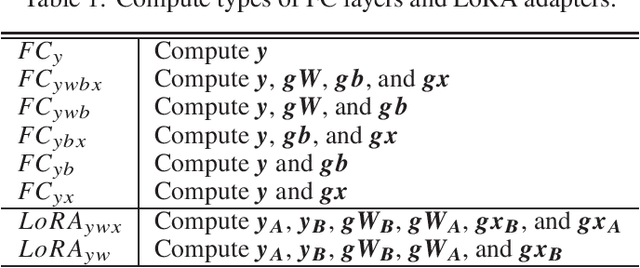
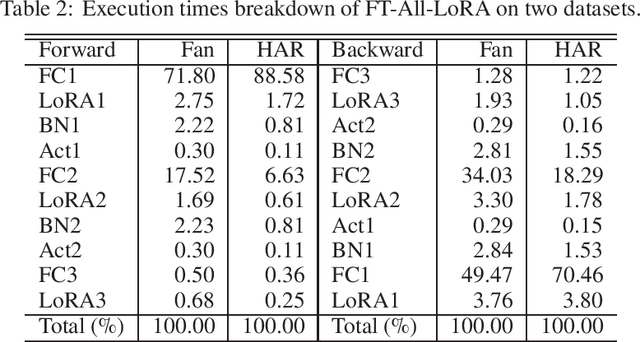
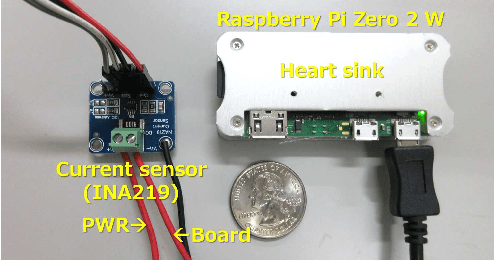
Abstract:This paper proposes Skip2-LoRA as a lightweight fine-tuning method for deep neural networks to address the gap between pre-trained and deployed models. In our approach, trainable LoRA (low-rank adaptation) adapters are inserted between the last layer and every other layer to enhance the network expressive power while keeping the backward computation cost low. This architecture is well-suited to cache intermediate computation results of the forward pass and then can skip the forward computation of seen samples as training epochs progress. We implemented the combination of the proposed architecture and cache, denoted as Skip2-LoRA, and tested it on a $15 single board computer. Our results show that Skip2-LoRA reduces the fine-tuning time by 90.0% on average compared to the counterpart that has the same number of trainable parameters while preserving the accuracy, while taking only a few seconds on the microcontroller board.
CrediRAG: Network-Augmented Credibility-Based Retrieval for Misinformation Detection in Reddit
Oct 15, 2024



Abstract:Fake news threatens democracy and exacerbates the polarization and divisions in society; therefore, accurately detecting online misinformation is the foundation of addressing this issue. We present CrediRAG, the first fake news detection model that combines language models with access to a rich external political knowledge base with a dense social network to detect fake news across social media at scale. CrediRAG uses a news retriever to initially assign a misinformation score to each post based on the source credibility of similar news articles to the post title content. CrediRAG then improves the initial retrieval estimations through a novel weighted post-to-post network connected based on shared commenters and weighted by the average stance of all shared commenters across every pair of posts. We achieve 11% increase in the F1-score in detecting misinformative posts over state-of-the-art methods. Extensive experiments conducted on curated real-world Reddit data of over 200,000 posts demonstrate the superior performance of CrediRAG on existing baselines. Thus, our approach offers a more accurate and scalable solution to combat the spread of fake news across social media platforms.
A Tiny Supervised ODL Core with Auto Data Pruning for Human Activity Recognition
Aug 02, 2024



Abstract:In this paper, we introduce a low-cost and low-power tiny supervised on-device learning (ODL) core that can address the distributional shift of input data for human activity recognition. Although ODL for resource-limited edge devices has been studied recently, how exactly to provide the training labels to these devices at runtime remains an open-issue. To address this problem, we propose to combine an automatic data pruning with supervised ODL to reduce the number queries needed to acquire predicted labels from a nearby teacher device and thus save power consumption during model retraining. The data pruning threshold is automatically tuned, eliminating a manual threshold tuning. As a tinyML solution at a few mW for the human activity recognition, we design a supervised ODL core that supports our automatic data pruning using a 45nm CMOS process technology. We show that the required memory size for the core is smaller than the same-shaped multilayer perceptron (MLP) and the power consumption is only 3.39mW. Experiments using a human activity recognition dataset show that the proposed automatic data pruning reduces the communication volume by 55.7% and power consumption accordingly with only 0.9% accuracy loss.
Scaling Graph Convolutions for Mobile Vision
Jun 09, 2024



Abstract:To compete with existing mobile architectures, MobileViG introduces Sparse Vision Graph Attention (SVGA), a fast token-mixing operator based on the principles of GNNs. However, MobileViG scales poorly with model size, falling at most 1% behind models with similar latency. This paper introduces Mobile Graph Convolution (MGC), a new vision graph neural network (ViG) module that solves this scaling problem. Our proposed mobile vision architecture, MobileViGv2, uses MGC to demonstrate the effectiveness of our approach. MGC improves on SVGA by increasing graph sparsity and introducing conditional positional encodings to the graph operation. Our smallest model, MobileViGv2-Ti, achieves a 77.7% top-1 accuracy on ImageNet-1K, 2% higher than MobileViG-Ti, with 0.9 ms inference latency on the iPhone 13 Mini NPU. Our largest model, MobileViGv2-B, achieves an 83.4% top-1 accuracy, 0.8% higher than MobileViG-B, with 2.7 ms inference latency. Besides image classification, we show that MobileViGv2 generalizes well to other tasks. For object detection and instance segmentation on MS COCO 2017, MobileViGv2-M outperforms MobileViG-M by 1.2 $AP^{box}$ and 0.7 $AP^{mask}$, and MobileViGv2-B outperforms MobileViG-B by 1.0 $AP^{box}$ and 0.7 $AP^{mask}$. For semantic segmentation on ADE20K, MobileViGv2-M achieves 42.9% $mIoU$ and MobileViGv2-B achieves 44.3% $mIoU$. Our code can be found at \url{https://github.com/SLDGroup/MobileViGv2}.
Ada-VE: Training-Free Consistent Video Editing Using Adaptive Motion Prior
Jun 07, 2024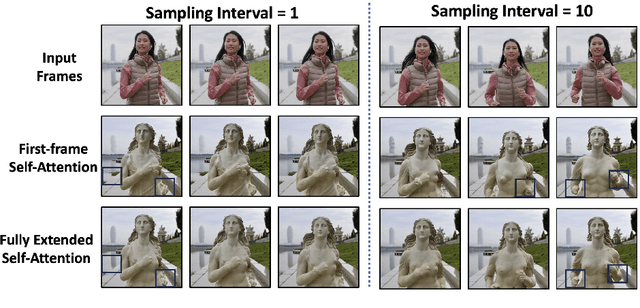
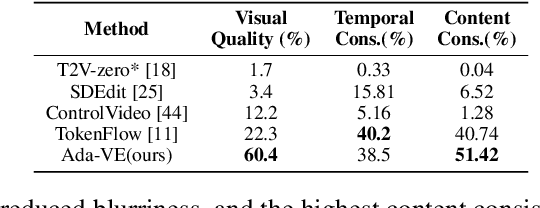
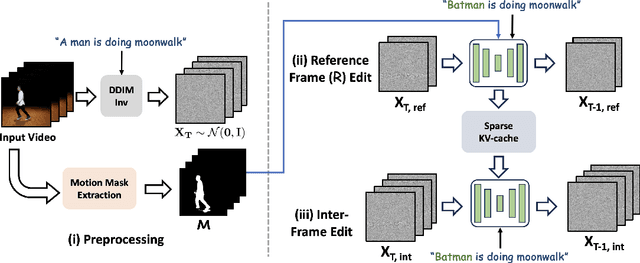
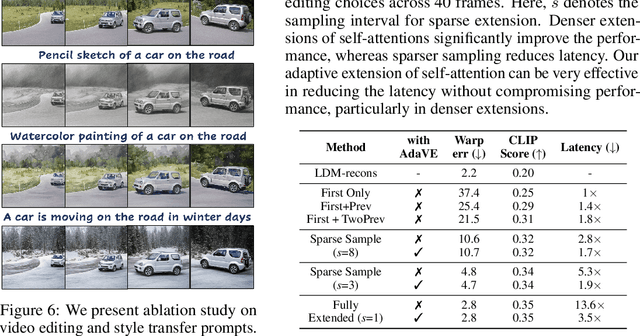
Abstract:Video-to-video synthesis models face significant challenges, such as ensuring consistent character generation across frames, maintaining smooth temporal transitions, and preserving quality during fast motion. The introduction of joint fully cross-frame self-attention mechanisms has improved character consistency, but this comes at the cost of increased computational complexity. This full cross-frame self-attention mechanism also incorporates redundant details and limits the number of frames that can be jointly edited due to its computational cost. Moreover, the lack of frames in cross-frame attention adversely affects temporal consistency and visual quality. To address these limitations, we propose a new adaptive motion-guided cross-frame attention mechanism that drastically reduces complexity while preserving semantic details and temporal consistency. Specifically, we selectively incorporate the moving regions of successive frames in cross-frame attention and sparsely include stationary regions based on optical flow sampling. This technique allows for an increased number of jointly edited frames without additional computational overhead. For longer duration of video editing, existing methods primarily focus on frame interpolation or flow-warping from jointly edited keyframes, which often results in blurry frames or reduced temporal consistency. To improve this, we introduce KV-caching of jointly edited frames and reuse the same KV across all intermediate frames, significantly enhancing both intermediate frame quality and temporal consistency. Overall, our motion-sampling method enables the use of around three times more keyframes than existing joint editing methods while maintaining superior prediction quality. Ada-VE achieves up to 4x speed-up when using fully-extended self-attention across 40 frames for joint editing, without compromising visual quality or temporal consistency.
 Add to Chrome
Add to Chrome Add to Firefox
Add to Firefox Add to Edge
Add to Edge